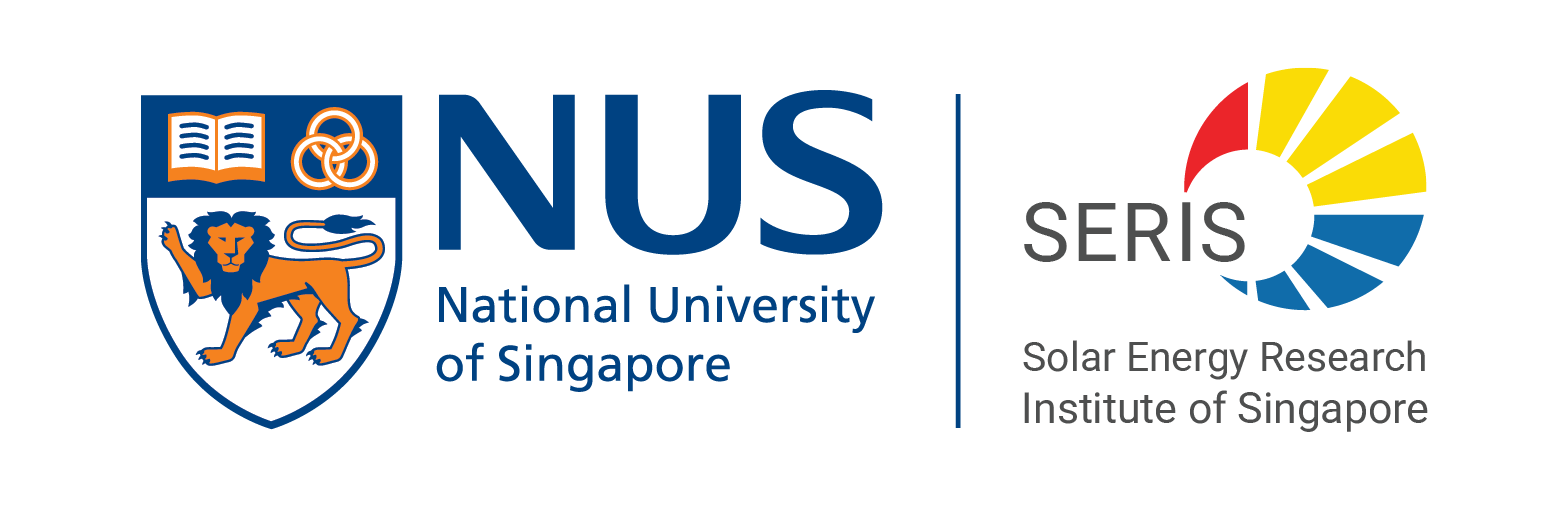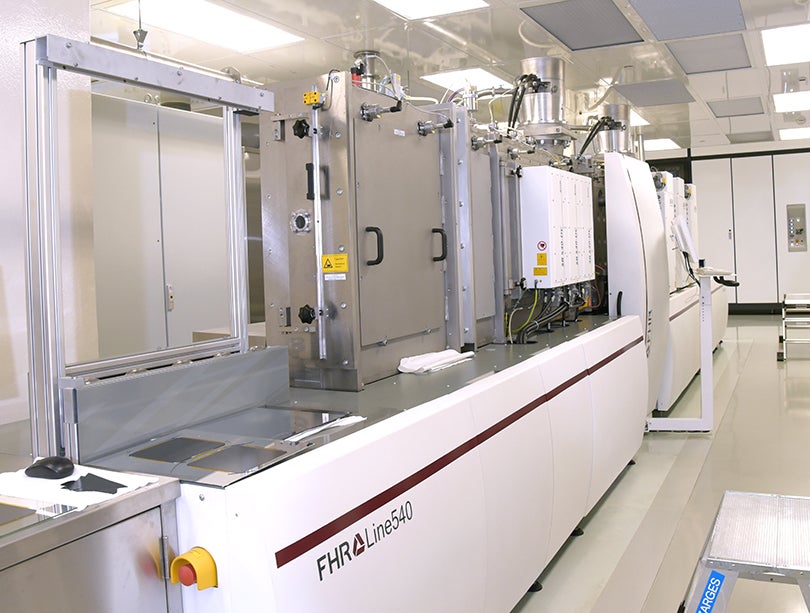This laboratory is located on levels 1 and 2 of the E3A building on the main NUS campus. Industrial tools with throughput of more than 100 wafers per hour enable industry-relevant solar cell R&D using monocrystalline silicon wafers.
Silicon Cleanroom Lab 1A
Lab 1A is used for wet-chemical processing of silicon wafers. It is equipped with highly versatile R&D equipment to develop advanced processes for high-efficiency Si solar cells as well as Si bottom cells for application in perovskite-silicon tandem cells. The lab also houses industrial-scale high-throughput wet-chemical process tools, enabling rapid technology transfer to industry.
These batch wet-chemistry tools were custom-built by MediaMac and include versatile process baths for developing various wet-chemical processes (cleaning, texturing, etching) related to silicon solar cell processing. The tools can process up to 50 silicon wafers per batch, with wafer sizes up to M10 and half-cut G12.
The BatchTex tool from RENA Technologies is a high-throughput (> 250 wafers/hr), automated wet-chemical processing system for processes such as etching, alkaline texturing, and cleaning of silicon wafers (up to M10 size and half-cut G12). It consists of several baths with automated bleed and feed function that help maintain the concentration of chemicals in the bath, resulting in excellent process control based on feedback from several sensors. The tool also has state-of-the-art O3-based wet-chemical process baths for advanced wafer cleaning, producing tailored surface morphologies and growing thin oxide films. The robotic arms enable automated, fast and safe processing with consistent performance.
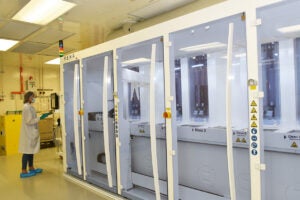
The InPilot tool from RENA Technologies provides inline wet-chemistry for single-side processing of silicon wafers (up to M10 size and half-cut G12). This is a semi-automated 1-lane machine for inline wet-chemical etching. It comprises an HF bath, an alkaline bath, and an acidic bath for single-sided wafer etching, with water rinses separating the chemical baths. The HF and alkaline baths can be heated.
Silicon Cleanroom Lab 1B
Lab 1B houses several chemical vapour deposition tools that can deposit various thin-film materials with thicknesses ranging from a few atoms thick to several hundred nanometres.
The R&D inline plasma-enhanced CVD (PECVD) machine MAiA 2.1 from Meyer Burger is a quasi-continuously operating high-throughput PECVD reactor (> 1000 wafers/hr for some processes). The deposition process uses a ‘remote' plasma energised by 2.54-GHz microwaves, inducing less damage to the Si wafers than the conventional parallel-plate approaches. The loading module is equipped with an infrared lamp array for rapid substrate heating to the process temperature (350-550 ºC). The machine deposits silicon nitride, silicon oxide and aluminium oxide films onto large silicon wafers (M2 to G12).
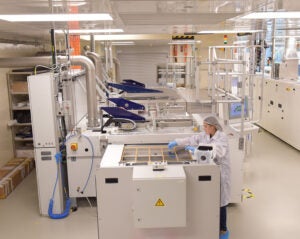
The Manual ALD Lab tool from SoLayTec is a pioneering R&D system developed for the deposition of Al2O3, intrinsic ZnO, Al-doped ZnO and SnO thin films using the spatial atomic layer deposition (sALD) technology, where precursors are separated in space rather than in time. The tool is able to deposit layers on a wide range of substrate types and sizes (up to G12 size wafers or 21 cm ´ 21 cm glass panes). While Al2O3 films are critical for further development of current silicon solar cell technologies, ZnO and SnO-based films will enable the development of transparent conductive oxides or transparent metal oxides for application in high-efficiency large-area perovskite-silicon tandem solar cells.
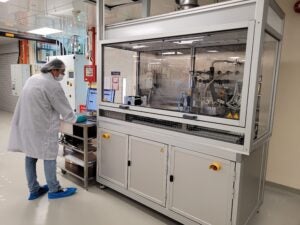
The TS81254 tube furnace from Tempress Systems is a 4-stack R&D high-throughput furnace featuring various process options: Low-pressure chemical vapour deposition (LPCVD) of doped & intrinsic poly-Si films for passivated-contact solar cell applications (double-sided deposition), doped & intrinsic silicon nitride deposition, oxidation for surface passivation applications.
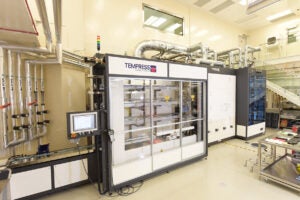
The CAiA Lab tool is a unique prototype PECVD tool for the ultra-fast deposition of intrinsic and doped silicon thin films and associated stacks, as well as doped transparent metal oxide films. The CAiA is the result of a joint development project by SERIS and Meyer Burger during the period 2017-2020. It has two process chambers to prevent cross-contamination. The tool enables the single-sided deposition of thin high-quality interfacial oxide layers and low-absorbing and dense doped-layer stacks on silicon wafers up to size M6. The tool is used for R&D on single-junction silicon solar cells as well as tandem devices with silicon bottom cells.

![]()
The Octopus II is a PECVD tool for the deposition of intrinsic and doped (boron, phosphorus) a-Si layers for applications in heterojunction silicon solar cells. The machine is capable of processing up to G12 wafers and is designed in a cluster form to provide process flexibility needed for the R&D purposes. The tool is also able to deposit various nanocrystalline layers like nc-Si, nc-SiOx, and nc-SiC.
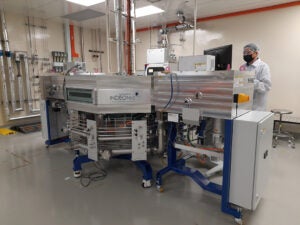
Silicon Cleanroom Lab 2A
Lab 2A houses tools for precision and advanced processing of high-efficiency solar cells. It has a versatile laser tool and an inkjet printing tool that are used to create advanced features on solar cells.
The ILS LT is an R&D laser processing workstation for high-precision applications in PV. The machine features three laser sources to provide excellent flexibility: a 2-W UV continuous source, a 20‑W green ns source, and a 30‑W fs source that can be tuned to operate at either UV, green or IR wavelengths. This configuration enables several process applications for high-efficiency solar cells, including contact opening, selective mask processing or edge/junction isolation, wafer drilling, wafer cutting, silicon shadow mask fabrication and laser marking for substrate ID tracking purposes. The tool has automated handling for substrates up to M6 size, and is also capable of processing larger wafers (up to G12 size) using manual handling.
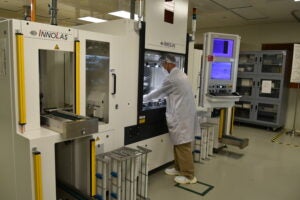
![]()
The IP410 is a versatile pilot-scale inkjet printer for solar cell masking and patterning applications. It supports a wide range of functional inks, including hotmelt inks, UV curable inks, solvent-based metal inks, and chemical precursor inks (e.g. for perovskite cells). Multiple printing modules are available to quickly switch between different ink types while avoiding cross contamination. An ink evaluation module with disposable cartridges allows to test small volumes of experimental inks. Printing patterns are digitally defined and thus can be quickly updated, which makes the machine ideal for process development and rapid prototyping. It is fully automated and includes cassette loading and unloading of wafers up to M6 size. Manual handling of larger wafers (up to G12) is also possible.
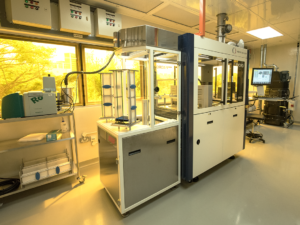
A 3-section glovebox setup is utilized to create a controlled, moisture-free environment essential for processing moisture-sensitive materials. This setup accommodates an inkjet printer, a spin coater, a hotplate and a chemical storage area. The integrated design ensures seamless contamination-free transfer of the samples throughout the system.
![]()
The PiXDRO inkjet printer, positioned in one section of the 3-section glovebox, operates in a controlled moisture-free environment. This pilot-line tool is capable of handling substrates up to G12 size (210 mm), making it ideal for the precise deposition of moisture-sensitive layers such as perovskite, ETL and HTL for industrial-size tandem solar cells. The printer also supports a wide range of functional inks and allows rapid switching between ink types with minimal risk of cross-contamination.
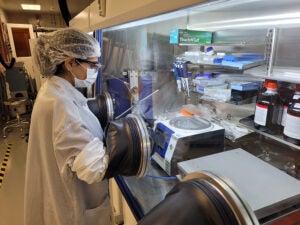
The spin coater, together with a hotplate, is housed in a separate section of the 3-section glovebox. This configuration ensures uniform deposition and curing of perovskite and other functional layers.
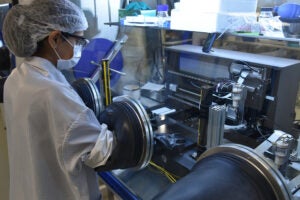
Silicon Metallisation Lab 2B
This laboratory facilitates metallisation and contact formation for different types of solar cells. It has multiple tools for advanced metallisation processes, suited for both high- and low-temperature applications.
This versatile R&D screen printer from ASYS, Germany is capable of screen printing metal contacts onto a wide range of substrate sizes, ranging from small (50 mm x 50 mm) to very large (210 mm x 210 mm, G12). The printer is also capable of stencil printing. The system is equipped with a patented vision alignment lens capability, i.e. smart assistance system, that uses a free moving camera and thus provides a lot of flexibility for aligning the substrates. This enables a repeatability of ± 10 µm by utilising a high-precision measuring system and an automatic screen adjustment system.
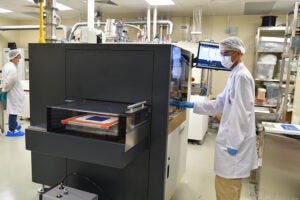
The SinTerra is an automated fast firing furnace from BTU/AMTECH Systems. It is equipped with automated cassette loading & unloading and has 6 zones with infrared lamps for heating Si wafers (up to M6 size) within a temperature range of 300-1000°C. Ramp-up and ramp-down rates can be precisely controlled in order to tailor the firing profiles.
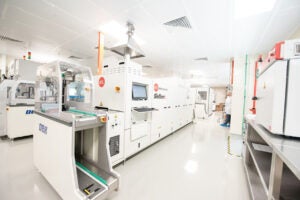
The SCT Thermal Evaporator is a lab-scale tool for evaporating thin films of metals and other materials (Al, Ag, etc) onto various substrates (wafers, glass panes, etc) of sizes up to G12. The deposition chamber uses a cryogenic pump to achieve a very low base pressure (< 10-6 Torr), ensuring high-purity films. The evaporator features dual resistively heated sources and a rotating substrate holder to ensure uniform depositions across large-area substrates.
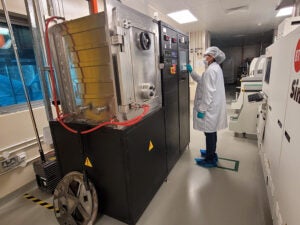
This physical vapour deposition (PVD) sputtering platform is designed to handle silicon wafers and glass panes. The SV-540 tool has dedicated processing chambers for the sputtering of metallic, dielectric and TCO/TMO layers. The chambers are equipped with planar magnetron sources for DC and RF sputtering of metals, oxides and oxynitrides in the reactive mode, and with a cylindrical dual-magnetron source and planar sources for pulsed DC (“DC+”) sputtering of dielectrics and TCOs/TMOs, with substrate heating up to 400ºC. It is also possible to deposit graded layers, or multi-layer stacks of up to 6 different materials, without breaking the vacuum conditions. Materials that can be sputtered include indium tin oxide, aluminium-doped zinc oxide, Ag, Al, Ti, Cu, In, ZnO and thin oxide and oxynitride tuned to specific requirements. The Line‑540 tool has three planar magnetron sources, of which two are connected to a DC power supply for DC sputtering of metal layers, while the third is connected to an RF power supply for the deposition of dielectric films such as iZnO and MgZnO4. Substrates of sizes up to 30 cm ´ 40 cm or up to six M6-size wafers can be processed per run at substrate temperatures of up to 200ºC.
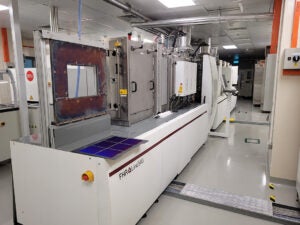
This inline sputtering tool from FHR Anlagenbau, Germany has three planar magnetron sources, whereby two sources are connected to a DC power supply for DC sputtering of metal layers, while the third source is connected to an RF power supply for the deposition of dielectric films such as ZnOS. Substrates of sizes up to 30 cm x 40 cm or up to six M4-size silicon wafers per run can be processed at substrate temperatures of up to 200oC. The tool is also used for deposition of Cu and other metal seed layers onto silicon wafers for subsequent plating.
